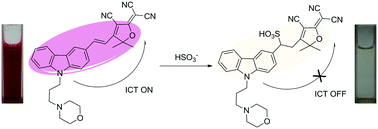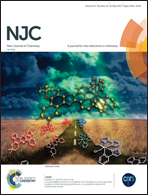A simple but effective fluorescent probe for the detection of bisulfite†
Abstract
A new fluorescence probe (PML) for sensing HSO3− was developed based on a Michael addition reaction mechanism. The probe was composed of carbazole and 2-(3-cyano-4,5,5-trimethylfuran-2(5H)-ylidene)malononitrile moieties and can be easily synthesized. The carbazole-based probe can selectively detect HSO3− and shows good sensitivity with the limit of detection of 2.08 × 10−6 M in a PBS : DMF = 1 : 1 buffer solution. Upon addition of HSO3−, the intense fluorescence of the probe was quenched, and the color markedly changed from red to colorless. In addition, the probe can be used to detect HSO3− in dry white wine.



 Please wait while we load your content...
Please wait while we load your content...